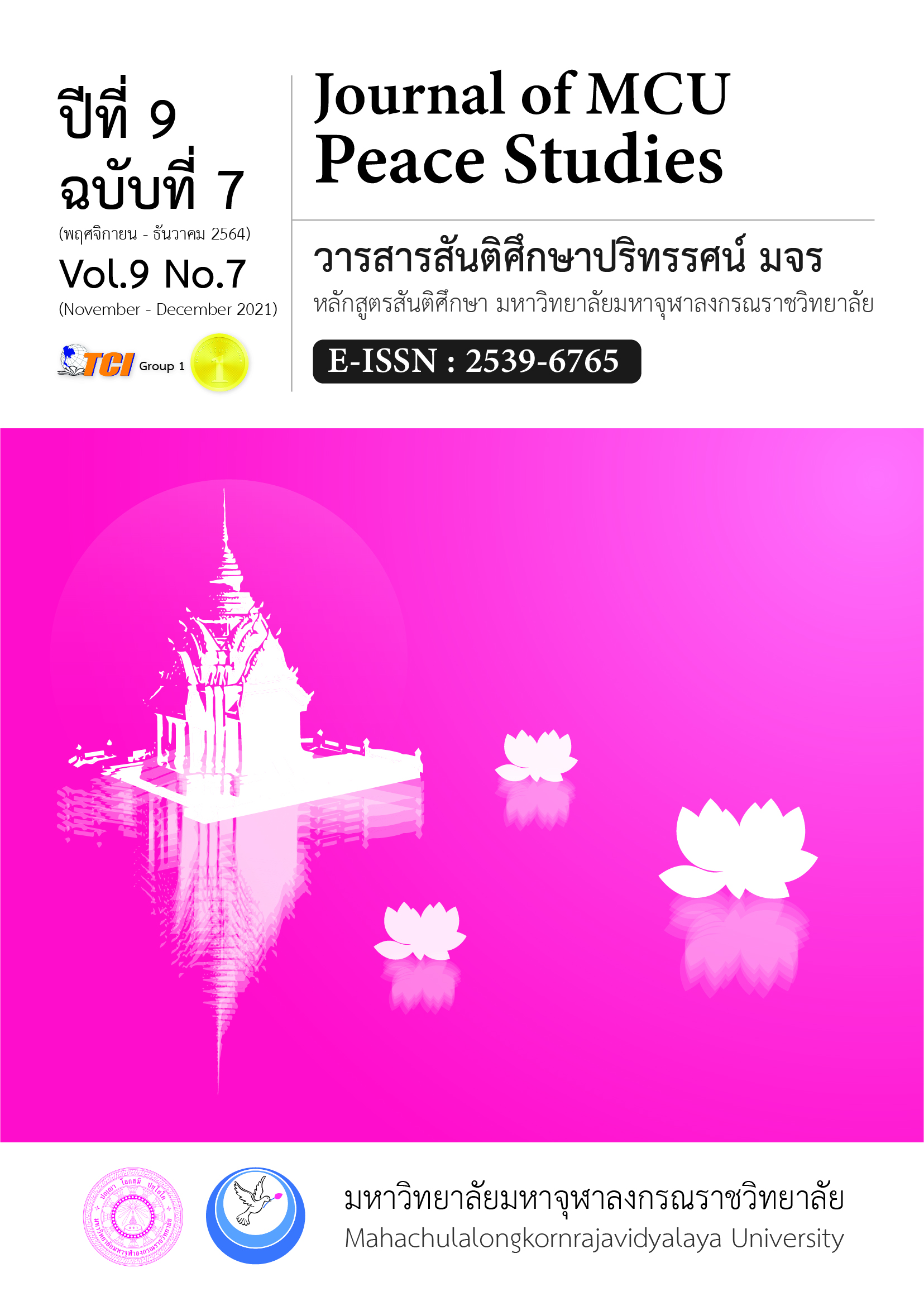บุพปัจจัยที่มีอิทธิพลต่อการตอบสนองของผู้บริโภค ผลิตภัณฑ์เครื่องสำอางออร์แกนิค
Main Article Content
บทคัดย่อ
บทความวิจัยนี้มีวัตถุประสงค์ เพื่อศึกษา 1) ระดับของการตอบสนองของผู้บริโภค ส่วนประสมทางการตลาด การรับรู้คุณค่าของเครื่องสำอางออร์แกนิค ทัศนคติของผู้บริโภค และ การรับรู้ตราสินค้า และ 2) อิทธิพลของส่วนประสมทางการตลาด การรับรู้คุณค่าของเครื่องสำอางออร์แกนิค ทัศนคติของผู้บริโภค และการรับรู้ตราสินค้าที่มีต่อการตอบสนองของผู้บริโภคผลิตภัณฑ์เครื่องสำอางออร์แกนิค การวิจัยนี้ใช้วิธีการวิจัยเชิงปริมาณ กลุ่มตัวอย่างคือ ผู้บริโภคผลิตภัณฑ์เครื่องสำอางออร์แกนิคที่เป็นเพศหญิง กลุ่มเจนเนอเรชั่น X และ Y รวมจำนวน 320 คน ขนาดของกลุ่มตัวอย่างกำหนดโดยใช้เกณฑ์ 20 เท่าของตัวแปรสังเกต ใช้วิธีการสุ่มตัวอย่างแบบหลายขั้นตอน เก็บข้อมูลด้วยแบบสอบถาม และวิเคราะห์ด้วยสถิติพรรณนา และแบบจำลองสมการโครงสร้าง ผลการวิจัยพบว่า 1) การตอบสนองของผู้บริโภค ส่วนประสมทางการตลาด การรับรู้คุณค่าของเครื่องสำอางออร์แกนิค ทัศนคติของผู้บริโภค และ การรับรู้ตราสินค้า อยู่ในระดับมาก และ 2) การรับรู้ตราสินค้า มีอิทธิพลโดยรวมต่อการตอบสนองของผู้บริโภค มากที่สุด รองลงมาคือ ส่วนประสมทางการตลาด ทัศนคติของผู้บริโภค และ การรับรู้คุณค่าของเครื่องสำอางออร์แกนิค ตามลำดับ ผลของการวิจัยนี้ เป็นการสร้างกลยุทธ์ความประทับใจให้ผู้บริโภคเหนือคู่แข่ง ด้วยการพัฒนาวิธีการที่ก้าวล้ำเหนือกว่าในอดีต และช่วยเพิ่มปริมาณลูกค้าประจำ และผลักดันให้อยู่เหนือคู่แข่งไปอีกขั้นในสนามแข่งขันทางธุรกิจ
Article Details

อนุญาตภายใต้เงื่อนไข Creative Commons Attribution-NonCommercial-NoDerivatives 4.0 International License.
ทัศนะและความคิดเห็นที่ปรากฏในบทความในวารสาร ถือเป็นความรับผิดชอบของผู้เขียนบทความนั้น และไม่ถือเป็นทัศนะและความรับผิดชอบของกองบรรณาธิการ ยินยอมว่าบทความเป็นลิขสิทธิ์ของวารสาร
เอกสารอ้างอิง
Aaker, D. A. (1991). Managing brand equity: Capitalizing on the value of a brand name. New York: The Free Press.
Aaker, D. A. (1996). Measuring brand equity across products and markets. California Management Review, 38(3).
Ahmed, S. N. B., & Judhi, N. (2010). Organic food: A study on demographic characteristics and factors influencing purchase intentions among consumers in Klang Valley. International Journal of Business and Management, 5(2), 105-118.
Ainunnazlee, M. A., & Aini, M. S. (2012). Demographic profile and purchasing pattern of organic cosmetic products.
Ajzen, I. (1991). The theory of planned behavior. Organizational Behavior and Human Decision Processes, 50(2), 179-211.
Ashton, A. S., Scott, N., Solnet, D., & Breakey, N. (2010). Hotel restaurant dining: The relationship between perceived value and intention to purchase. Tourism and Hospitality Research, 10(3), 206-218.
Bendixen, M., Bukasa, K. A., & Abratt, R. (2004). Brand equity in the business-to-business market. Industrial Marketing Management, 33(5), 371-380.
Bhat, S. , & Reddy, S. K. (1998). Symbolic and functional positioning of brands. Journal of Consumer Marketing, 15(1), 32-43.
Chen, M. F. (2011). The joint moderating effect of health consciousness and healthy lifestyle on consumers’ willingness to use functional foods in Taiwan. Appetite, 57(1), 253-262.
Chen, T. B. , & Chai, L. T. (2010). Attitude towards the environment and green products: consumers' perspective. Management Science and Engineering, 4(2), 27.
Cowan, K., & Kinley, T. (2014). Green spirit: consumer empathies for green apparel. International Journal of Consumer Studies, 38(5), 493-499.
Eggert, A., & Ulaga, W. (2002). Customer perceived value: a substitute for satisfaction in business markets? Journal of Business & industrial marketing, 17(2/3), 107-118.
Govindasamy, R. et al. (2001). Empirically evaluating consumer characteristics and satisfaction with organic products. New Jersey: Department of Agricultural, Food and Resource Economics, The State University of New Jersey.
Johe, M. H., & Bhullar, N. (2016).To buy or not to buy: The roles of self-identity, attitudes, perceived behavioral control and norms in organic consumerism. Ecological Economics, 128, 99-105.
Kasikorn Research Center. (2018). Beauty business market is still nice, a winning trading Business. Retrieved August 12, 2019, from https//www.kasikornbank.com.th/business/sme/KSMEKnowledge/article/KSMEAnalysis/ Documents/Beauty-Business_Trend.pdf.
Keller, K. L. (2003). Brand synthesis: The multidimensionality of brand knowledge. Journal of Consumer Research, 29(4), 595-600.
Kline, R. B. (2005). Principle and practice of structural equation modeling. NY: Guilford.
Kotler, P. (2003). Marketing for hospitality and tourism. New Jersey: Prentice Hall.
Kotler, P., Armstrong, G., Saunders, J., & Wong, V. (2004). Consumer behavior (5th ed.). Prentice Hall.
Marketeer. (2018). Thai women do not stop beautiful, the beauty market does not stop growing. Retrieved August 23, 2019, from https://marketeeronline.co/archives/17541.
McDougall, G. H., & Levesque, T. (2000). Customer satisfaction with services: Putting perceived value into the equation. Journal of Services Marketing, 14(5), 392-410.
Phawanthaksa. (2019). 2019 Golden opportunity for cosmetics and skin care businesses Retrieved August, 12, 2019 from https://www.smartsme.co.th/content/218721.
Rashid, N. R. N. A. , Jusoff, K. , & Kassim, K. M. (2009). Eco-Labeling Perspectives amongst Malaysian Consumers/ LES PERSPECTIVES DE L'ECO- ETIQUETAGE CHEZ LES CONSOMMATEURS MALAISIENS. Canadian Social Science, 5(2), 1.
Schermelleh-Engel, K., Moosbrugger, H., & Müller, H. (2003). Evaluating the fit of structural equation models: Tests of significance and descriptive goodness-of-fit measures. Methods of Psychological Research Online, 8(2), 23-74.
Siu, N., & Wong, Y. (2002). The impact of product-related factors on perceived product safety. Marketing Intelligence & Planning, 20(3), 185-194.
Song, B. L., Safari, M., & Mansori, S. (2016). The marketing stimuli factors influencing consumers’ attitudes to purchase organic food. International Journal of Business and Management, 11(10), 109-119.
Sweeney, J. C. , & Soutar, G. N. (2001). Consumer perceived value: The development of a multiple item scale. Journal of Retailing, 77(2), 203-220.
Thansettakij. (2018). Beauty business 2019, trend "Nature" so hot. Thansettakij newspaper 3(415), 4-7.
Tonglet, M. , Phillips, P. S. , & Read, A. D. (2004). Using the Theory of Planned Behavior to investigate the determinants of recycling behavior: a case study from Brixworth, UK. Resources, Conservation and Recycling, 41(3), 191-214.
Ulaga, W., & Eggert, A. (2004). Relationship value and relationship quality: Broadening the nomological network of business-to-business relationships. European Journal of Marketing, 40(3/4), 311-327.
Umberson, K. ( 2008). Environmentally friendly purchase intentions: Debunking the misconception behind apathetic consumer attitudes. University of North Texas.
Vazifehdoust, H., Taleghani, M., Esmaeilpour, F., & Nazari, K. (2013). Purchasing green to become greener: Factors influence consumers’ green purchasing behavior. Management Science Letters, 3(9), 2489-2500.
Voon, J. P., Ngui, K. S., & Agrawal, A. (2011). Determinants of willingness to purchase organic food: An exploratory study using structural equation modeling. International Food and Agribusiness Management Review, 14(2), 103-120.
Kroeber-Riel, W., & Weinberg, P. (2003). Konsumentenverhalten. Germany: Vahlen. Wonglorsaichon, P., & Sathainrapabayut, P. (2008). Brand perception and brand equity of baby accessory products in working moms ‘perspective. International Review of Business
Research Papers, 4(1), 385-395.
Zhen, J. S., & Mansori, S. (2012). Young female motivations for purchase of organic food in Malaysia. International Journal of Contemporary Business Studies, 3(5), 61-72.
Zheng, Y., & Chi, T. (2015). Factors influencing purchase intention towards environmentally friendly apparel: An empirical study of US consumers. International Journal of Fashion Design, Technology and Education, 8(2), 68-77.


